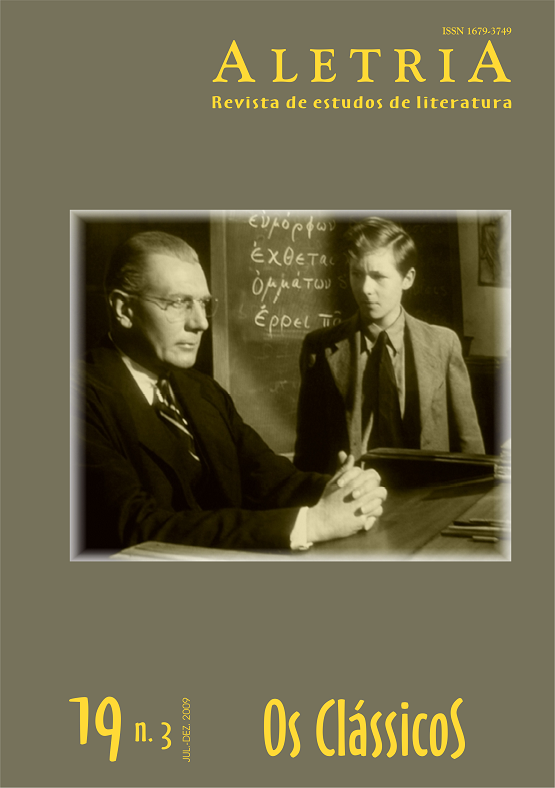A 'mise en abyme' como recurso eniano nos anais
DOI:
https://doi.org/10.17851/2317-2096.19.3.47-56Palavras-chave:
Ênio, Anais, mise en abyme, Annals.Resumo
Resumo: No fragmento 22 do primeiro canto dos Anais (ed. Valmaggi), Quinto Ênio (239—ca. 169 a.C.) apresenta a sua versão da concepção dos gêmeos Rômulo e Remo, numa cena em que a narrativa do poeta contém o discurso de Ília, mãe dos gêmeos, recém-acordada de um sonho bastante agitado. Na fala de Ília, insere-se a fala do seu pai, um discurso dentro de outro discurso. O procedimento do récit enchâssé cria um efeito de mise en abyme que tem especial relevância para a leitura interpretativa do fragmento, por sua vez criador de uma segunda mise en abyme nos Anais. Outro sonho narrado no primeiro canto, o de Ênio com Homero (fr.2-8), liga-se ao de Ília também pela mise em abyme, gerando novas leituras intratextuais.
Palavras-chave: Ênio; Anais; mise en abyme.
Abstract: In fragment 22 from the first book of the Annals (ed. Valmaggi), Quintus Ennius (239–ca. 169 BC) provides us with his version of the twins’ Romulus and Remus conception, in a scene in which the poet’s narrative contains the twins’ mother’s speech, Ilia’s, the description of the dream she’s just had. In Ilia’s line, we hear her father speak–a speech within a speech. This récit enchâssé produces the effect of a mise en abyme that bears special relevance to the interpretative reading of the fragment, which in its turn creates a second mise en abyme through its insertion in the Annals. Narrated in the first book, another dream, in which Ennius sees Homer (fragments 2-8), is also connected to Ilia’s through the mise en abyme’s effect, thus generating new intratextual reading possibilities.
Keywords: Ennius, Annals, Mise en abyme.
Downloads
Referências
BAYET, Jean. Littérature latine. Paris: Librairie Armand Colin, 1969.
CICERO. De Senectute, De Amicitia, De Diuinatione. With an English translation by William Armistead Falconer. Cambridge/ Massachussetts/ London: Harvard University Press and William Heinemann Ltd:, 1979. 568 p.
COURTNEY, Edward. The Fragmentary Latin Poets. New York: Oxford University Press, 2003. 540 p.
DÄLLENBACH, Lucien. Le récit spéculaire: essai sur la mise en abyme. Paris: Éditions du Seuil, 1977. 247 p.
DÄLLENBACH, Lucien. Intertexto e autotexto. In: ______. “Poétique”: intertextualidades. Trad. Clara Crabbé Rocha. Coimbra: Livraria Almedina, 1979. v. 27. p. 51-76.
DÄLLENBACH, Lucien; TOMARKEN, Annette. Reflexivity and Reading. New Literary History, v. 11, n. 3, “On Narrative and Narratives”: II, p. 435-449, Spring 1980.
DOMINIK, William J. From Greece to Rome: Ennius’ Annales. In: BOYLE, A. J. (Ed.). Roman Epic. London / New York: Routledge, 1993. p. 37-58.
ELLIOTT, Jacqueline. The Voices of Ennius Annals. In: FITZGERALD, William; GOWRS, Emily (Ed.). Ennius perennis. The Annals and Beyond. Cambridge Classical Journal. Proceedings of the Cambridge Philological Society. Supplementary Volume 31. Cambridge: CUP, 2007.
HARRIS, W. V. Roman Opinions About the Truthfulness of Dreams. The Journal of Roman Studies, v. 93, p. 18-34, 2003.
HEFFERNAN, James A. W. Museum of Words: The Poetics of Ekphrasis from Homer to Ashbery. Chicago/ London: The University of Chicago Press, 1993. 249 p.
MARTINS, Nilce Sant’Anna. Introdução à estilística: a expressividade na língua portuguesa. 3. ed. São Paulo: T. A. Queiroz, 2000. 259 p.
MARTOS, Juan. Ennio: Fragmentos. Madrid: Editorial Gredos, 2006. 567 p.
MORENO, Manuel Segura. Quinto Ennio. Fragmentos. Madrid: Consejo Superior de Investigaciones Científicas, 1999. 159 p.
NATIVIDADE, Everton da Silva. Os Anais de Quinto Ênio: estudo, tradução e notas. São Paulo, Universidade de São Paulo (Dissertação policopiada). 264 p.
NÓBREGA, Vandick Londres da. A epopéia de Ênio: exegese e crítica. Rio de Janeiro, Universidade do Brasil (tese policopiada), 1963. 110 p.
PATTERSON, Lee W. Rapt With Pleasaunce: Vision and Narration in the Epic. ELH, v. 48, n. 3, p 455-475, 1981.
PEREIRA, Maria Helena da Rocha. Estudos de história da cultura clássica. II Volume – Cultura Romana. 3. ed. Lisboa: Fundação Calouste Gulbenkian, 2002. 580 p.
SKUTSCH, Otto. The Annals of Quintus Ennius. New York: Oxford University Press, 1985. 848 p.
SOUZA, Sebastião Gonçalves de. Fragmentos de Névio e Ênio. Rio de Janeiro, Universidade Federal do Rio de Janeiro (tese policopiada), 1989. 286 p.
STEUART, Ethel Mary. The Annals of Quintus Ennius. Hildesheim / New York: Georg Holms Verlag, 1976. 246p.
VALMAGGI, Luigi (Ed.). Q. Ennio: I frammenti degli Annali. Torino: Casa Editrice Giovanni Chiantore, 1945. 163 p.
VASCONCELLOS, Paulo Sérgio de. Efeitos intertextuais na Eneida de Virgílio. São Paulo: Humanitas, 2001. 400 p.
WARMINGTON, E. H. (Ed.). Remains of Old Latin. Cambridge, Massachusetts, London: Harvard University Press, 1988. v. 1. 598 p.
Downloads
Publicado
Edição
Seção
Licença
Copyright (c) 2009 Everton Natividade (Autor)

Este trabalho está licenciado sob uma licença Creative Commons Attribution 4.0 International License.
Autores que publicam nesta revista concordam com os seguintes termos:Autores mantém os direitos autorais e concedem à revista o direito de primeira publicação, com o trabalho simultaneamente licenciado sob a Licença Creative Commons Attribution que permite o compartilhamento do trabalho com reconhecimento da autoria e publicação inicial nesta revista.Autores têm autorização para assumir contratos adicionais separadamente, para distribuição não-exclusiva da versão do trabalho publicada nesta revista (ex.: publicar em repositório institucional ou como capítulo de livro), com reconhecimento de autoria e publicação inicial nesta revista.Autores têm permissão e são estimulados a publicar e distribuir seu trabalho online (ex.: em repositórios institucionais ou na sua página pessoal) a qualquer ponto antes ou durante o processo editorial, já que isso pode gerar alterações produtivas, bem como aumentar o impacto e a citação do trabalho publicado (Veja The Effect of Open Access).














